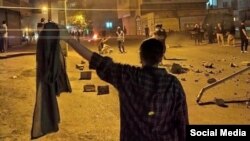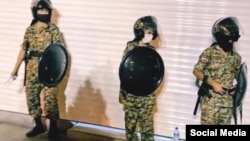
Welcome back to The Farda Briefing, an RFE/RL newsletter that tracks the key issues in Iran and explains why they matter.
I'm RFE/RL correspondent Golnaz Esfandiari. Here's what I’ve been following during the past week and what I’m watching for in the days ahead.
The Big Issue
Young people have played a prominent role in the ongoing anti-government protests that have rocked Iran for the past month. Young women and teenage girls have taken to the streets in major cities, removing and burning their head scarves.
In universities and high schools, female students have chanted “Woman, life, freedom” and called on Iran’s ruling “mullahs” to get lost.
Some of them have paid with their lives. The United Nations says at least 23 children, including an 11-year-old boy, have been killed by security forces during the government’s crackdown on the protests.
Hundreds more have been injured, detained, and tortured since the protests erupted on September 17, the UN said. Some of those detained have been sent to so-called “re-education centers.”
Among those killed were 16-year-old girls, Nika Shakarami and Sarina Esmailzadeh, who have become some of the most prominent faces of the protests.
One of the latest victims was Asra Panahi, a 16-year-old schoolgirl who was beaten by security forces in the northwestern city of Ardabil for refusing to sing a pro-establishment anthem when her school was raided by agents.
The UN Committee on the Rights of the Child on October 17 condemned what it said were “grave violations of children's rights” in Iran and urged the authorities “to stop all violence against children.”
Why It Matters: The gap is widening between Iran’s young population and the ruling clerics. Many of Iran’s Internet-savvy youth want greater social and political freedoms.
The clerical establishment, meanwhile, has responded to those calls with violence and repression. The gulf between the regime and the population has never been so wide, and young Iranians have never been so brazen in demanding their rights.
What’s Next: The government’s deadly crackdown is unlikely to discourage young Iranians from venting their anger in public, including through protest art and acts of acts of civil disobedience.
The protests, which have entered a fifth week, are scattered. But they persist, with young Iranians often taking the lead.
Stories You Might Have Missed
• Iran’s western Kurdistan region has become the epicenter of the protests and the focus of the government’s crackdown. The death of Mahsa Amini, who hailed from Kurdistan, was the catalyst for the nationwide protests. Rights groups said on October 17 that at least 39 people have been killed in three predominately Kurdish provinces.
The harshest government crackdowns have occurred in Sanandaj, the provincial capital of Kurdistan, and in Amini’s hometown of Saghez. Amateur videos from the area appear to show security forces using firearms and tear gas and firing directly into residential homes. An even bloodier crackdown has occurred in Sistan-Baluchistan, where at least 95 people have been killed.
The province is under a strict lockdown and Internet blackout, making it difficult for observers to ascertain what is happening there.
• A billboard showing dozens of famous Iranian women, including athletes, actresses, and writers, all observing the mandatory hijab was taken down in Tehran less than 24 hours after going up following widespread criticism.
Amini died three days after she was detained by Iran’s morality police for allegedly violating the country’s hijab law. Some of the women on the billboard demanded that their picture be removed. One of them was the award-winning actress Fatemeh Motamed-Arya, whose emotional video went viral on social media.
The billboard was erected by the Owj Arts and Media Organization, which is affiliated with the Islamic Revolutionary Guards Corps. The organization said it removed the billboard following “controversies and reactions.”
What We're Watching
Iran’s judiciary said eight inmates died in a fire in Tehran’s Evin Prison.
The authorities blamed the blaze on “riots and clashes” among prisoners. But rights groups have questioned the official version of events and expressed concern that the real death toll could be much higher.
Explosions and gunshots could be heard in amateur videos posted on social media.
Prominent filmmaker Jafar Panahi managed to call his wife from the prison to let her know that he and fellow filmmaker Mohammad Rasoulof were fine and that the authorities had used tear gas during the unrest, RFE/RL’s Radio Farda reported.
Why It Matters: Evin is one of Iran’s most notorious and tightly-guarded prisons.
Dual and foreign nationals as well as some of Iran’s most prominent political prisoners are incarcerated there.
The unrest has renewed concerns about the treatment of prisoners in Evin.
Following the incident, rights groups have urged the authorities to allow international monitors unhindered access to the prison to investigate the alleged use of force against inmates.
That’s all from me for now. Don’t forget to send me any questions, comments, or tips that you have.
Until next time,
Golnaz Esfandiari
If you enjoyed this briefing and don't want to miss the next edition, subscribe here. It will be sent to your inbox every Wednesday.





